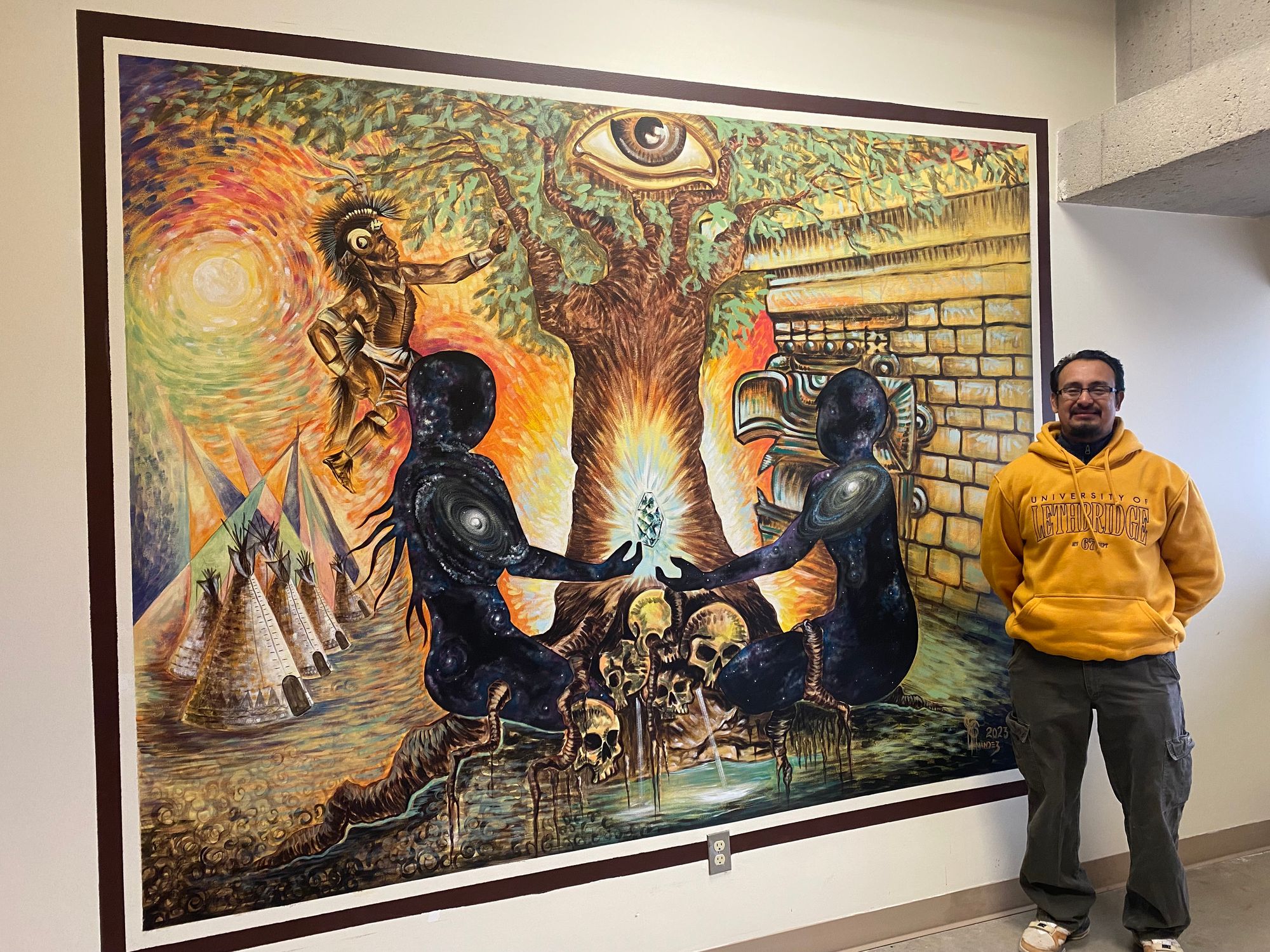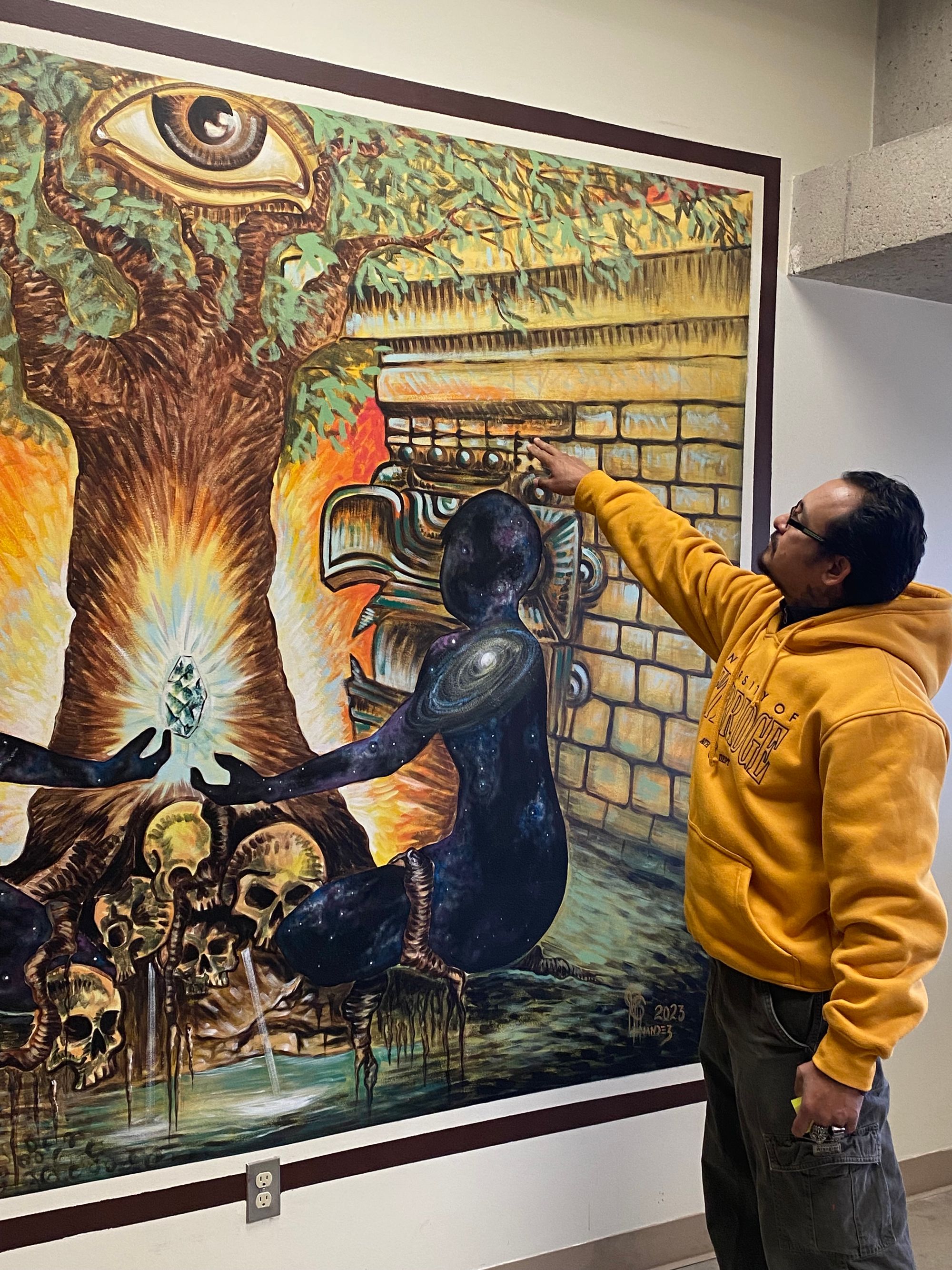Inspired by his experience as an international exchange student at the University of Lethbridge, Roberto Hernandez Tun has painted a vivid work of art depicting the bridging of Blackfoot and Mayan Indigenous cultures. Titled Knowledge and Pride Between Two Cultures, the mural was commissioned by Miguelzinta Solís (MFA '19), assistant professor of Indigenous Art Studio in the Faculty of Fine Arts.
Roberto was one of four exchange students from Universidad Intercultural Maya de Quintana Roo (UIMQRoo), México. He is currently in his sixth semester studying fine arts and obtained an Emerging Leaders in the Americas Program scholarship, which allowed him to spend his Spring 2023 semester at ULethbridge.
The mural was born from Roberto’s vision, inspired by the connections he made, and experiences shared with Indigenous Peoples while he was a student. His artistry unfolded with around 50 hours of work over 10 days. “This idea was like a light in my mind, and I received it like a gift and just put it on the wall. It was something incredible,” he says.

The artwork depicts the convergence of the Mayan culture, which is part of Roberto’s heritage, and the Blackfoot culture, which Roberto says he was grateful to learn more about through his studies at ULethbridge. “For me it was a really big experience,” says Roberto.
“I love the way you are trying to rescue all the old and ancient Indigenous knowledge and traditions in this school. For me, it’s important how we can share the knowledge and, in my case, my history with my Mayan culture. That's why in my mural, the two people are in the centre sharing something precious.”
In Mayan culture, it is a magic stone called sastun (sas-toon), a tool of divination and spiritual power used by Maya H’men, or shaman, since ancient times. “Sastun is the stone of the divine, and is something really precious for them, so I use it to show this sharing of knowledge,” says Roberto. The corner of the wall on the right of the painting depicts Chac, the Mayan god of rain. He is considered one of the most important deities in Mayan worldview, Roberto explains. “Something particular about Chac is how in these times we are still praying for him to ask for the rain, because the rain will catch everything; it is hard to explain. It is like a synchronism between Catholicism and the ultimate Mayan gods.”

The tree in the centre connects the universe with its branches, human beings at its core and the underworld below its roots. This symbolizes the entrance to the underworld with the skulls and Ah Puch, a Mayan god of death. “And the world is like a portal for the souls,” says Roberto. The eye in the centre of the tree represents energy from the universe, looking to everyone regardless of their background.
Roberto drew on his learnings about the Blackfoot culture to paint the tipis on the left, which all face to the East, to witness the sun rise and gather its morning warmth. He painted a chicken dancer in the way of earlier times “because it’s something coming from the past to the future,” he says. “Something important is the universe forming the bodies (in the centre). I think we human beings, we are energy. We are energy from the universe. We are just here, trapped in these bodies. And when we die, we come back to the universe.”
Roberto discovered his passion for art when he was around nine years old. Over the years, and with many different art instructors, Roberto honed his skills and his passion grew. Today, he shares his talent working as a children’s art instructor, painting murals and participating in art auctions.
Although Roberto's exchange with ULethbridge has come to an end, the mural will live on as a special gift in Professor Solís’s office, and for anyone who would like to stop by and admire it.
“This opportunity with Professor Miguel (Solís) to have the chance to paint here was great for me,” says Roberto. “To be here, I am so grateful. If possible, one day I would like to come back and paint a bigger one for ULethbridge to give thanks for everything, and maybe do a master’s here.”
Roberto also plans to write a book about his experiences at ULethbridge and learning about First Nations in Canada.
This May, 18 ULethbridge Indigenous students will travel with Dr. Michelle Hogue (MEd '04), associate professor (Faculty of Arts & Science) and coordinator for Indigenous Student Success Cohort, to Mexico for three weeks. It is part of a summer course—INDG 2850: Bridging Indigenous Cultures Between Canada and Mexico—which creates opportunities to explore and learn about connections with culture. The exchange is supported by funding from Universities Canada, the Mastercard Foundation and the TD Bank, as well as the partnership between ULethbridge and UIMQRoo.
Students on the exchange will learn about the Mayan culture, including Mayan and Spanish language. They will also work with Mayan students at UIMQRoo, visit their communities and travel to important sites in the Yucatan peninsula. "For many this is their first time travelling away," says Hogue. "It is a chance to truly bridge their Canadian Indigenous culture with the Mexican Mayan Indigenous culture and learn from each other."